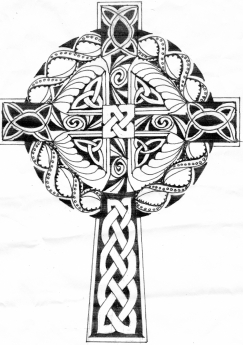



The Parish Church of St George the Martyr, Waterlooville

Of all the images associated with religious devotion, none is more eminent than the Cross. Indeed, this icon is profoundly associated with Christianity. In addition to the cross depicting Christ’s suffering, there are many other types, devised and used not only for religious contemplation but also in art, heraldry, a fashion accessory and also political persuasion.
One such variation is called the Celtic Cross. Essentially this consists of two motifs -
It is said that St Patrick took and adapted the design from Wales to Ireland. One myth is that it was a druidic design -
Rod has decorated and designed his version of the Celtic Christian Cross. In it, the close examiner will find:
King Solomon’s Knot
The Triquetra
The Vesica Piscis
The Fish outline
The four-
The Roman Rope Mosaic design
-
Rod Dawson
Autumn Edition 2011
The Celtic Cross
